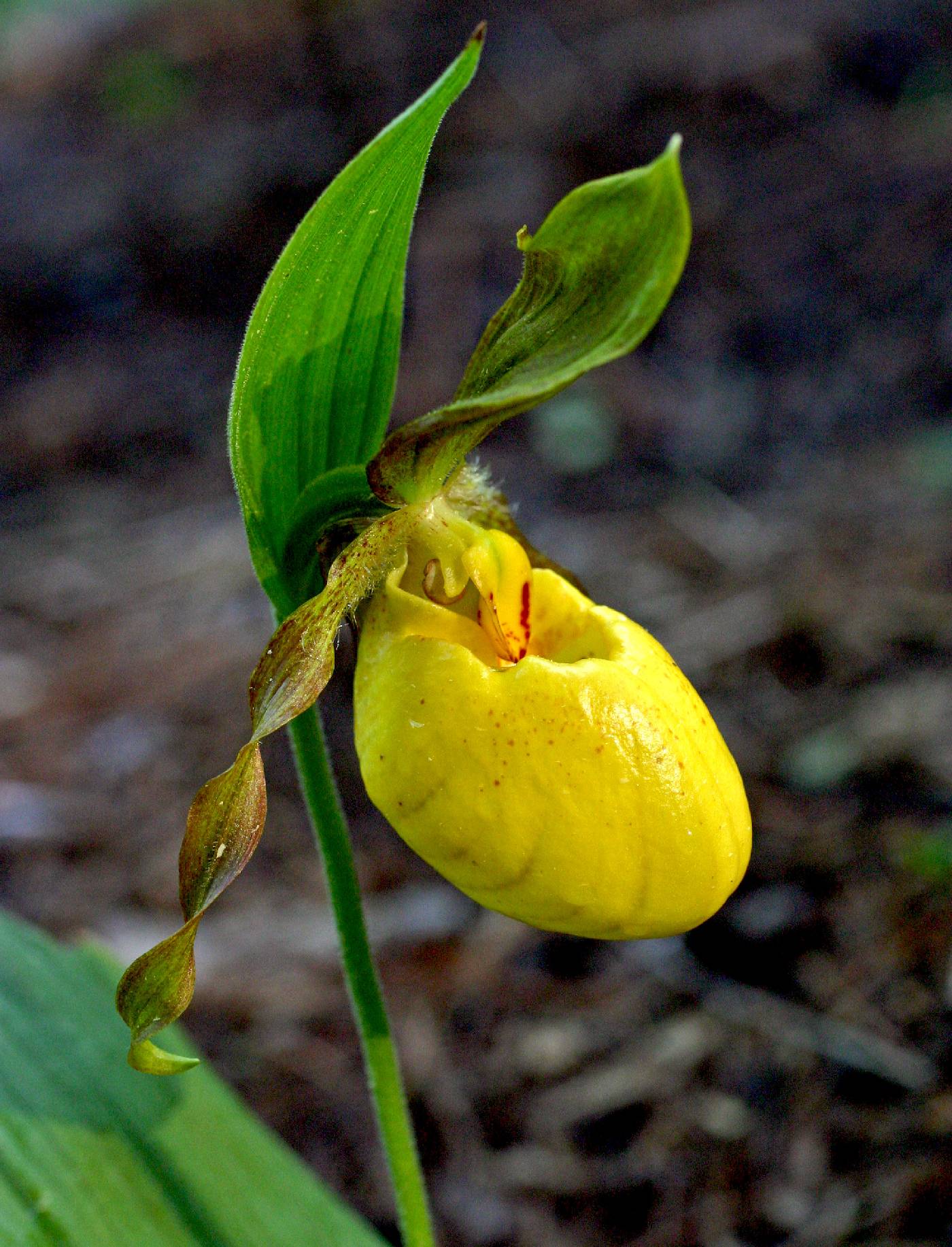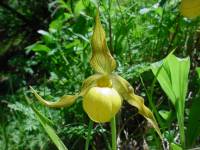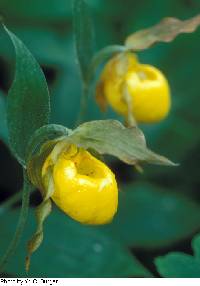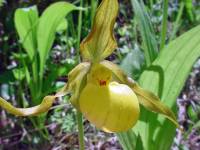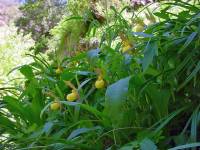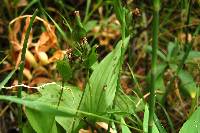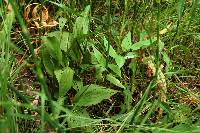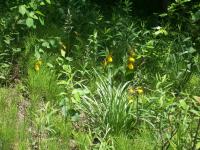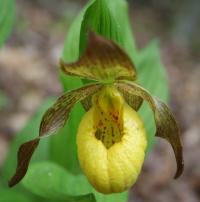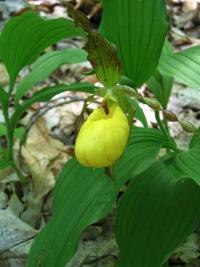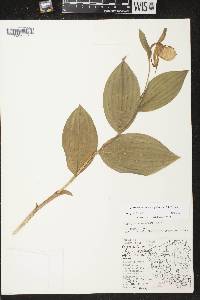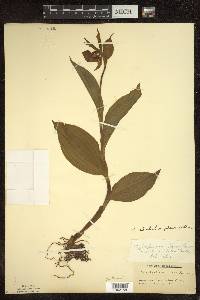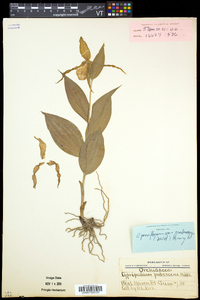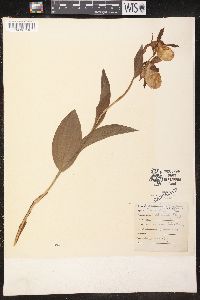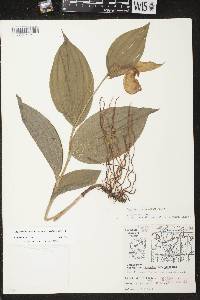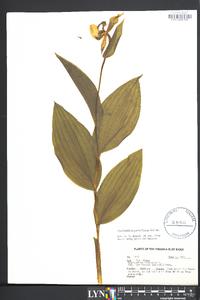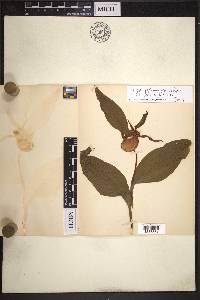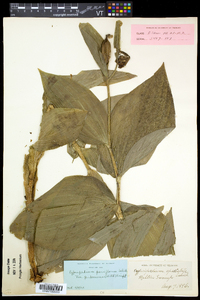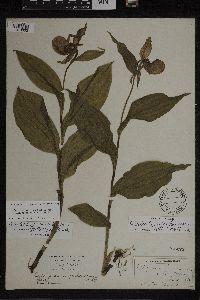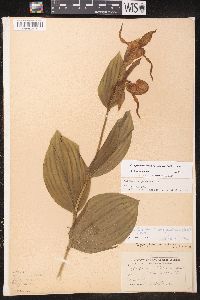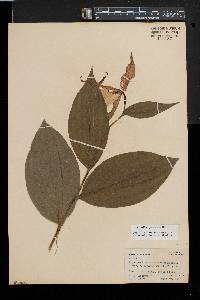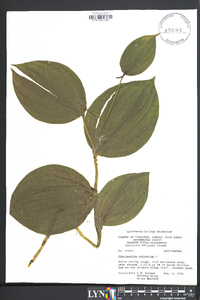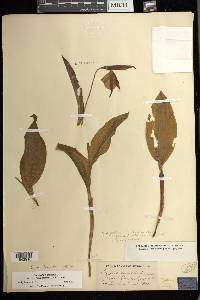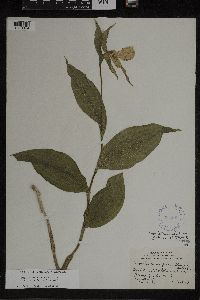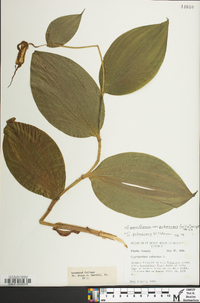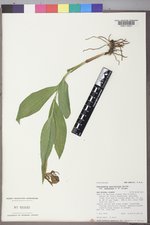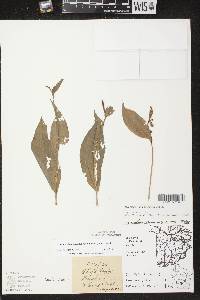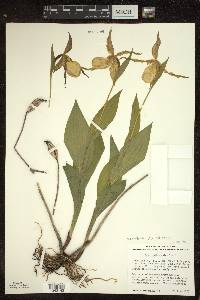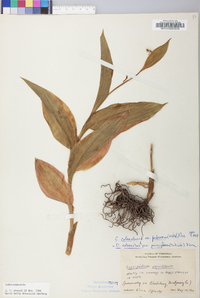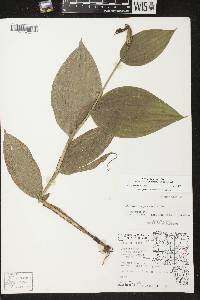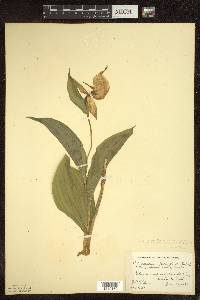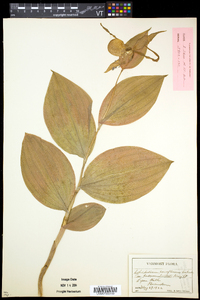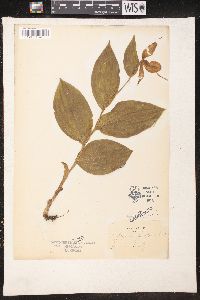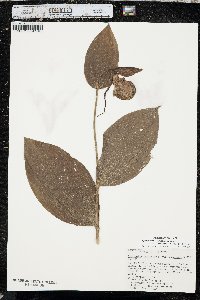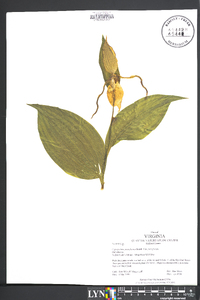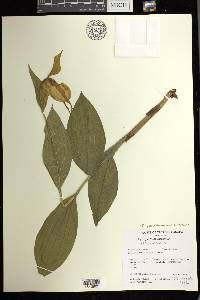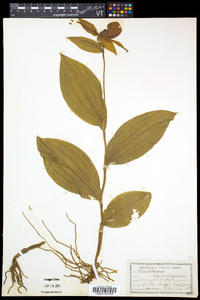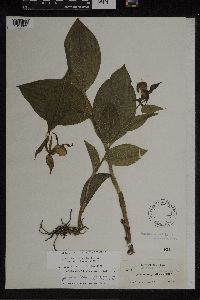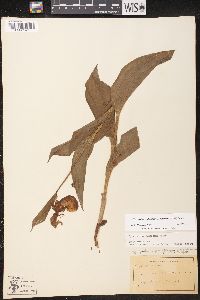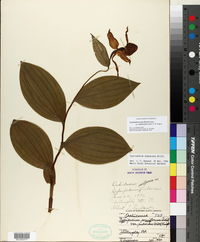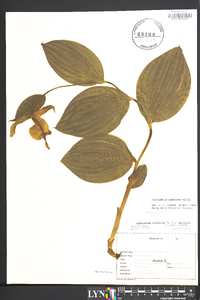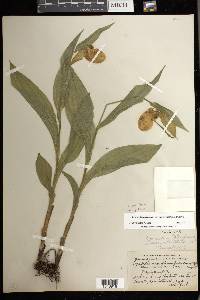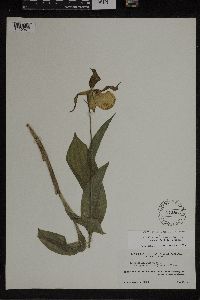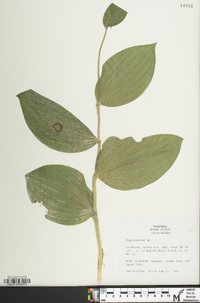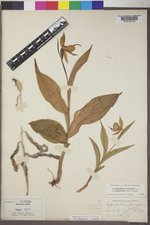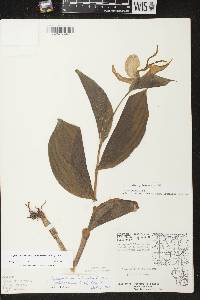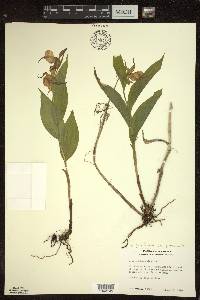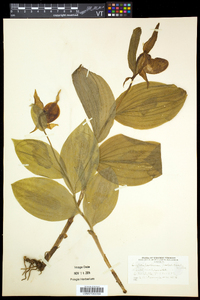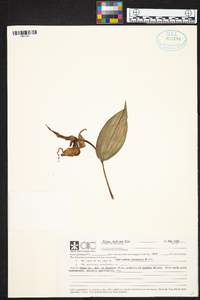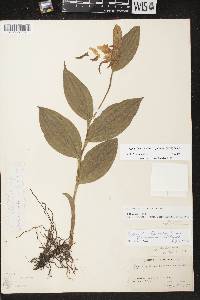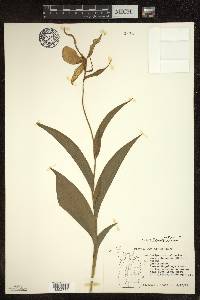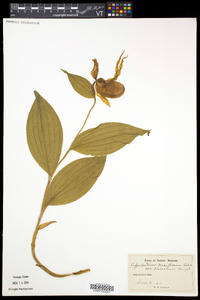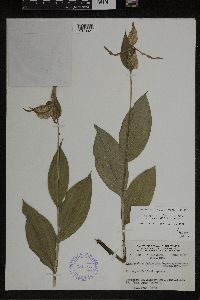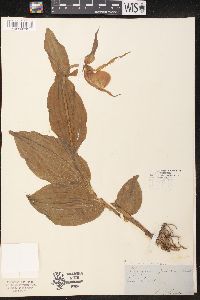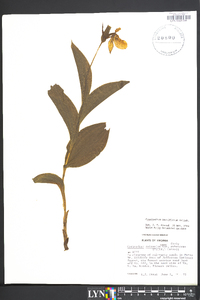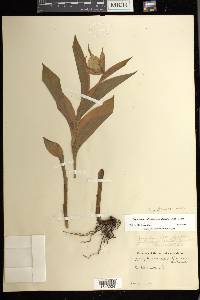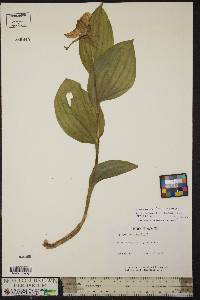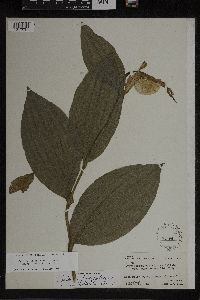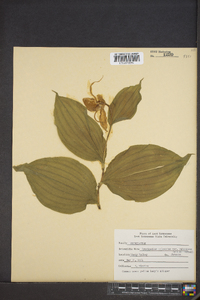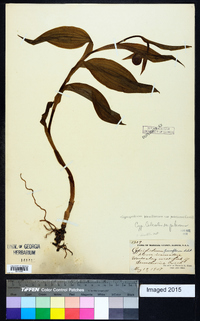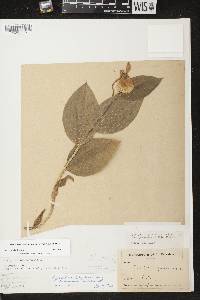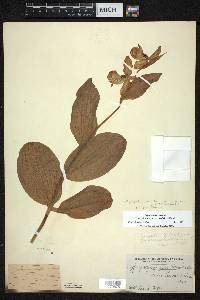Cypripedium parviflorum var. pubescens
|
|
|
|
Family: Orchidaceae
Greater Yellow Lady's-Slipper, more...hairy ladyslipper, yellow ladyslipper
[Cypripedium calceolus var. planipetalum (Fern.) Victorin & Rouss., moreCypripedium calceolus var. pubescens (Willd.) Correll, Cypripedium furcatum Raf., Cypripedium parviflorum var. planipetalum Fernald, Cypripedium planipetalum (Fern.) Morris & Eames, Cypripedium pubescens Willd., Cypripedium pubescens var. pubescens] |
Bracts: abaxial surface of distalmost sheathing bract (and often the next) densely and conspicuously silvery-pubescent when young (later sometimes glabrescent). Leaves 3-5, on proximal portion of or more evenly spaced along stem, alternate, erect to spreading; blade orbiculate or broadly ovate to elliptic-lanceolate or oblanceolate, 7.9-20.9 × 1.5-12 cm. Flowers 1-2, large to rather small (very small in some boreal and northern cordilleran specimens), scent moderate to faint, rose or musty; sepals commonly spotted, striped, and reticulately marked with reddish brown or madder, rarely extensively blotched or wholly unmarked; lip oblance-ovoid to calceolate or subglobose, 20-54 mm; orifice 10-23(-27) mm. 2n = 20. Flowering Apr--Aug. Mesic deciduous and coniferous forest, openings, thickets, prairies, meadows, fens; 0--2900 m; Alta., B.C., Man., N.B., Nfld. and Labr., N.W.T., N.S., Ont., Que., Sask.; Ariz., Colo., Conn., D.C., Ga., Ill., Ind., Iowa, Kans., Ky., Maine, Md., Mass., Mich., Minn., Miss., Mo., Mont., N.H., N.J., N.Mex., N.Y., N.C., Ohio, Oreg., Pa., R.I., Tenn., Utah, Vt., Va., Wash., W.Va., Wis. Perennial herb 10 - 80 cm tall Stem: one, erect, green, leafy, stout, and densely hairy. Leaves: three to five, often clustered near base, alternate in two ranks, erect to spreading, stalkless, strongly sheathing at base (especially early in season), bright green, 5 - 20.9 cm long, 5 - 12 cm wide, egg-shaped to widely elliptic, non-toothed, rarely folded lengthwise, strongly ribbed, deeply veined, and obviously hairy. Inflorescence: of one (rarely two), erect, terminal, long-stalked flower closely subtended by a stalkless, sheathing, erect, green, leaf-like, large (7 - 10 cm long), wide (5 - 12 cm), rarely folded, widely egg-shaped bract with tapering pointed tip. The bract base strongly sheaths the flower stalk, and the blade underside is densely and conspicuously covered with silver hairs when young, and may become less dense to almost hairless later. Sepals: three, but two lower fused together (except at tip) into a greenish or yellow-brown (commonly spotted or striped with red-brown), 4 - 5 cm long, 1.5 - 2 cm wide, hairy synsepal positioned closely behind and below lip petal. The remaining sepal is similar in color and hairiness, but is typically longer (up to 7.5 cm ), 1 - 3.5 cm wide, egg- to lance-shaped with wavy edges, and positioned uppermost arching forward above the inflated lip petal. Fruit: one, long-stalked, fairly erect, hairy, ellipsoid to nearly oval (often broadest above middle) capsule with remnant reproductive parts at tip, raised lengthwise angles, and stalk subtended only by basal sheath of bract. Root system: of slender, fleshy, fibrous, true roots arising from rhizomes. Flower: showy, faintly must-scented (or rose-like), pale to deep clear yellow, hairy, bilaterally symmetric with highly modified, very inflated, rounded lip petal that usually droops a little. Unlike other orchids, the reproductive parts of stamens and stigma are not fused into a column above the inferior ovary, but instead at the basal opening of the lip petal there are two separate anthers, one large, sterile, modified staminode, and a lobed stigma above the hairy inferior ovary. Lateral petals: two, horizontal to strongly descending, same color as sepals, hairy, 4 - 9 cm long, at least 1 cm wide, tightly spirally twisted, linear to narrowly lance-shaped. Lip petal: one, central, lowermost, pale to deep clear yellow, hairy, 1.5 - 6.5 cm long, about 3 cm wide, greatly inflated, pouch-like, widely egg-shaped or almost globose. The inner surface of the pouch is streaked and spotted with maroon or brown-purple, which appears faintly on the outside (especially along the bottom), and there are commonly maroon spots along the edge of the basal opening (orifice) of the petal. Basal orifice 1 - 2.5 cm long, with outer edge (opposite staminode) forming blunt obtuse angle. Staminode: one, prominent, yellow with a few red spots, triangular, and positioned below upper sepal and pointing down into basal opening (orifice) of lip. On the back side of the staminode the two anthers are positioned on each side of the central lobed stigma. Similar species: Cypripedium parviflorum var. pubescens is most similar to the other variety in our area, C. parviflorum var. makasin, but that variety differs by having less dramatically clasping leaves that are typically folded lengthwise, the under surface of the sheathing bract is hairless or only inconspicuously hairy when young, the flowers are smaller (lip 1.5 - 2.9 cm long) and often there are two per stem, the sepals and lateral petals are entirely or at least extensively marked with dark reddish brown or maroon, and the floral scent is intense and sweet like vanilla. The hybrid C. x andrewsii is also very similar, but it never has clear yellow lip petals, rather the lip is typically dull off-white (either ivory-white, or pale cream then fading to dull yellowish), and commonly hybrids have sepals and lateral petals that are entirely maroon or dark red-brown. Flowering: late April to June Habitat and ecology: Uncommon, a more upland plant preferring subacidic to neutral soils, primarily in mesic to dry-mesic upland forests, woodlands with deep humus or layers of leaf litter, shaded boggy habitats, but also in hill prairies and occasionally in wetlands with organic, well-drained, sandy soils. Occurence in the Chicago region: native Notes: Tolerating a much more wide array of habitats than the other varieties of yellow lady's slipper, C. parviflorum var. pubescens displays the most variation in morphology of the three varieties. This variety tends to have the largest flowers while the other variety in the Chicago Region usually has smaller flowers, but small-flowered forms of the large yellow lady's slipper are not uncommon. In addition, the amount of hairiness can fluctuate between populations and habitats. Since it is more uncommon for this variety to overlap habitats with those also supporting C. candidum, it is much more rare to find hybrids of these taxa, which can be called C. x andrewsii nothovariety favillianum (J.T. Curtis) B. Boivin. This cross yields flowers with pale cream lips which fade to dirty white or dull yellow, and sepals and lateral petals that are greenish yellow and streaked with brown. Etymology: Cypripedium comes from combining the Greek word Kypris for Cypris (Aphrodite), the goddess of love and beauty; and either the Latin word pedis meaning foot, or possibly an orthrographic error for the Greek word pedilon meaning sandal or slipper; together translating roughly to beauty's or lady's foot or slipper, in reference to the inflated lip petal resembling a woman's slipper or shoe. Parviflorum means small flower, which refers to the relative small size of the flowers. Pubescens means hairy in reference to the overall more obvious hairs throughout this variety. Author: The Field Museum FNA 2003, Kearney and Peebles 1969, McDougall 1973 Duration: Perennial Nativity: Native Lifeform: Forb/Herb General: Herbaceous perennials, to 1 m tall or more, stems erect. Leaves: Alternate, usually 3-5, orbiculate to broadly ovate or oblanceolate to elliptic-lanceolate, 8-21 cm long and 1.5-12 cm wide, erect to spreading, proximal or more evenly spaced along the stem. Flowers: Flowers bright yellow, large and showy, with a protruding lower lip petal and 3 large, lanceolate bracts with one top bract and 2 side bracts on either side of the lower lip, the lip yellow or rarely white, oblanceolate-ovoid or subglobose, 20-54 mm long, the throats 10-27 mm wide, the distal most bract (and often the next) with the underside sheathing and densely and conspicuously silvery-pubescent when young, later sometimes becoming glabrescent, sepals 19-80 mm long and spreading wide, commonly spotted, striped, and reticulately marked with reddish brown or madder, rarely extensively blotched or wholly unmarked, staminodes cordiform-ovoid, deltoid, lance-ovoid, or ovoid-oblong, flowers borne in groups of 1-2, with a moderate to faint, rose or musty scent. Fruits: Capsules dehiscing by longitudinal slits. Seeds numerous, minute, the endosperm absent. Ecology: Found in moist soils, in shade, in mesic deciduous and coniferous forest, openings, thickets, prairies, meadows, fens, around 9,500 ft (2896 m); flowering June-July. Distribution: Newfoundland to British-Columbia, south to Georgia, Arizona, and Washington; Europe. Notes: These exotic orchids are a beautiful bright yellow, and are large and showy with grass-like leaves. Look for this species in Arizona in Apache county in the White Mountains, in moist soils. Synonyms: Many, see Tropicos Editor: LCrumbacher2012 Etymology: Cypripedium comes from the Greek Kypris, a name for Aphrodite, and pedilon, "a slipper," alluding to the shape of the flowers, parviflorum comes from the Greek parvus, "small," and flora, "flower," hence "small-flowered", and pubescens means with soft, downy hair. Relatively robust, with large fls, the pet 5-8 cm, the lip 3-5 cm, occurs in mesic woods nearly throughout our range. (C. pubescens) Gleason, Henry A. & Cronquist, Arthur J. 1991. Manual of vascular plants of northeastern United States and adjacent Canada. lxxv + 910 pp. ©The New York Botanical Garden. All rights reserved. Used by permission. From Flora of Indiana (1940) by Charles C. Deam The large-flowered variety seems to be quite distinct from the typical form for the most part but intergrading specimens have influenced some authors to regard it as a nutritional form. Some claim that when the large-flowered form is transplanted it will change in time to the small-flowered form. This transition is contradicted by the experience of others. Until it is proven that the one is merely a passing form of the other it is best to regard them as distinct with intergrading forms. In Indiana the habitat seems to distinguish them. The variety [pubescens] grows in deep leaf mold in moist or dry woods while the typical form [var. parviflorum] grows for the most part in very wet or boggy places. The habitat distinction, however, does not hold even for the few specimens I have. All of my specimens of the typical form grew in boggy places except one which grew in woodland. All of my specimens of the variety [pubescens] grew in woodland except one that grew in a tamarack bog. |
|
|
|

